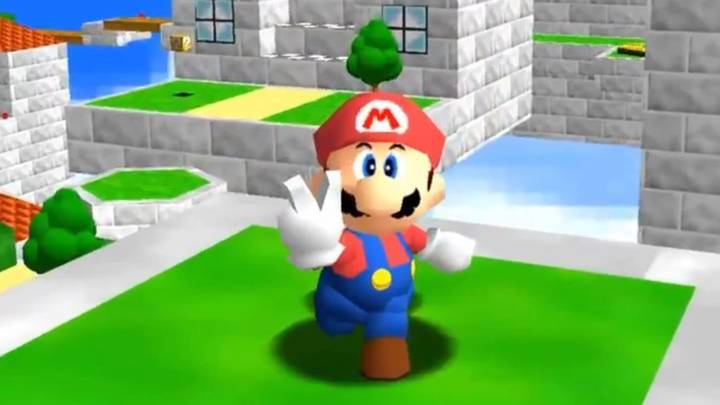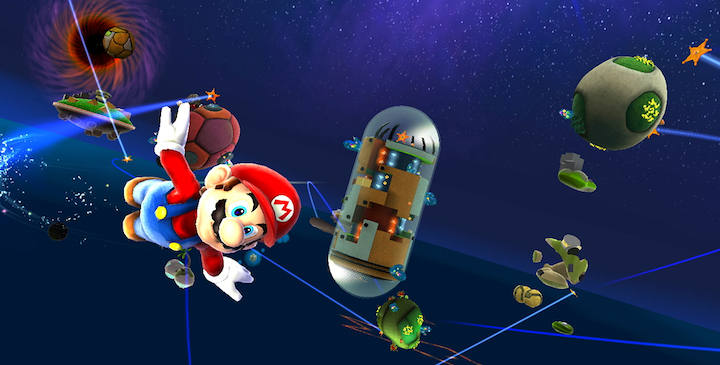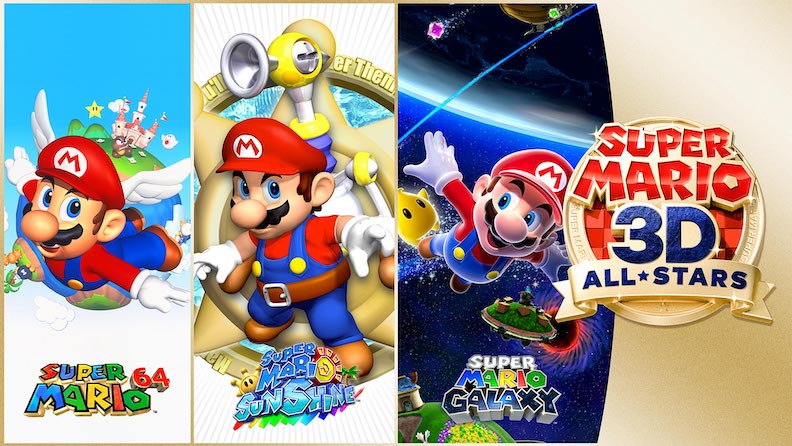Editor’s Note: This post is provided to us by friend of the site TRAVIS BANKS.
2020 marks the 35th anniversary of Super Mario Bros., and with that comes another celebration of the most well-known video game character in history. This time, it’s in the form of three Super Mario video game re-releases: Super Mario 64, Super Mario Sunshine, and Super Mario Galaxy. Collectively known as Super Mario 3D All-Stars, the game was released as a “limited edition” (only available for sale until March 2021) item on September 18, 2020.
Super Mario 3D All-Stars was officially announced by Nintendo on September 3, 2020. The game had been rumored as early as March, but then Covid-19 happened, and it was sort of forgotten about until the end of the summer. The announcement was immediately met with criticism from gamers; did Nintendo seriously announce a combo of re-releases for $60?
The complaints are justified.
Nintendo has always been weird about game re-releases. Remember buying digital versions of games on the Wii Shop Channel, and NOT being able to carry them over to the Wii U? Remember buying a re-released console game on one of Nintendo’s handheld systems? Remember the limited edition 25th Anniversary Mario collection for the Wii in 2010?
Nintendo has always had some type of market for its first-party games, and I can’t blast the company for continuing to make money off of them. In fact, being able to play these older video games on the Switch was my primary reason for the purchase; my Gamecube and Wii have long been in storage, and my N64 gets hooked up twice a year at best for nostalgia reasons.
With all that in mind, I have to ask: is Super Mario 3D All-Stars REALLY all that bad?

Super Mario 64 is the first game in the lineup, and perhaps the most iconic. For most people my age, Super Mario 64 was the game that parents bought with the Nintendo 64 on its launch in September 1996. The image of a 3D Mario popping up on screen welcoming you to the game was mind-blowing at the time, and the “open world” of the Mushroom Kingdom was an amazing sight to see.
The game plays about the same as it did on the Nintendo 64. The Switch Joycons are a lot better to use than the old N64 controller, but the camera angles are still wonky at times. Visually, the game looks great… for an N64 game. The number of polygons in the models have been increased a bit for HDTV, so they look sharper around the edges, but still fairly blocky. The audio is improved as well, but there is only so much you can do with Nintendo 64 MIDI files. Having not played the game in more than a decade, when it was released on the original Nintendo DS, I can say that it looks MUCH better than that particular version. However, I do miss the ability to pick different characters throughout the game.
The biggest complaint about the port will likely be that the game isn’t in 16:9 widescreen, but the original 4:3 format. It doesn’t bother me, personally, as I would prefer to watch movies/shows and play games in their natural state. I can see how some people might be annoyed by it, though, especially when the other two games in the set are in widescreen.

The next game in the trio is also probably one of the most controversial. Super Mario Sunshine was originally released on August 26, 2002 in North America for the Nintendo Gamecube, a GREAT system that happened to be one of Nintendo’s lowest-selling consoles, so not as many gamers played Sunshine as they did previous Mario titles. It was a tiny bit controversial – when the Gamecube was released in 2001, there was no Mario launch title available to play, which went against Nintendo tradition of the time. Instead, Luigi was given a chance to shine with Luigi’s Mansion. Mario’s title finally came around about 8 months later… and people were disappointed.
The most common complaint about the game was that it felt like a clone of SM64. While it DID maintain much of the same gameplay mechanics as its predecessor (such as an open world with warp points used to play levels in various worlds/areas), the game did have some new additions, such as Mario’s backpack, F.L.U.D.D., which collected water from the game’s tropical island settings, which could then be used to spray enemies or remove toxic goop from around the Isle of Delfino. Or used as jets to turn F.L.U.D.D. into a temporary jetpack!
The controls are very similar to the original Gamecube version, in terms of the button layout. But the Gamecube had my favorite console controller ever, so it’s a bit harder to play on the smaller Switch Joycons without the natural grips the Gamecube controller had. The first person POV is pretty much required to defeat some bosses and enemies, and getting there feels a bit unnatural on the Switch’s handheld mode. But the real killer is the lack of the option to invert the controls. As someone who always inverts the Y Axis, it takes some getting used to.
Visually, the game looks, well, mostly the same as how I remember playing it on a 4:3 tube TV back in 2002. The models are more refined, however, thanks to the Switch’s processing power, and the additional polygons and such. The game starts off purposefully dark, but once you obtain a few Shine Sprites, Isle Delfino looks glorious under the bright sun.

My memories of Super Mario Galaxy are not as fond as the memories of 64 and Sunshine, but that is through no fault of the game. When the game was originally released on November 12, 2007 in North America, I was in college, and wasn’t playing many video games. I received a copy of the game for Christmas, but only played it sparingly until I finally beat it years later. I can’t tell you much about the game, outside of the introduction of Rosalina, who has been involved in Nintendo properties such as Super Smash Brothers and Mario Kart ever since.
Playing through the first hour or so of the game took some adjusting, mainly because of the controls. If you play the game with your Switch docked, it takes advantage of the Switch’s motion controls in order to recreate the motion controls of the Wii’s Wiimote. This is fine, but it makes the game frustrating to play in handheld mode because you have to touch the screen with a stylus or your finger in order to collect all of the star pieces.
Like Sunshine, Galaxy looks great on the Switch. The Wii’s graphics were equivalent to the Playstation 2, but the game has been cleaned up a bit for HDTV and the improved power of the Switch. Like Sunshine, Galaxy plays in widescreen.
The audio for all three games is incredible, and as an added bonus, the game includes the original soundtracks for all three games. You can select the soundtracks at the main menu, and it makes for great background noise if you don’t want to actually play a game.
In summary, the criticisms of Super Mario 3D All-Stars are well-earned. For $60 – the cost of a new video game – you get three old video games (that you likely already own) with no changes whatsoever. Why buy them again when you could download an emulator?
To answer my question from earlier, no, Super Mario 3D All-Stars is not that bad. In fact, I recommend it, especially for any younger gamers who haven’t ever played the titles before. But ultimately it comes down to personal taste. Do you want to be able to play these games on a modern console that is also portable? Or are you content with your original games and original systems? If it’s the former, you likely already bought All-Stars, and if it’s the latter, you probably weren’t buying it anyway.
